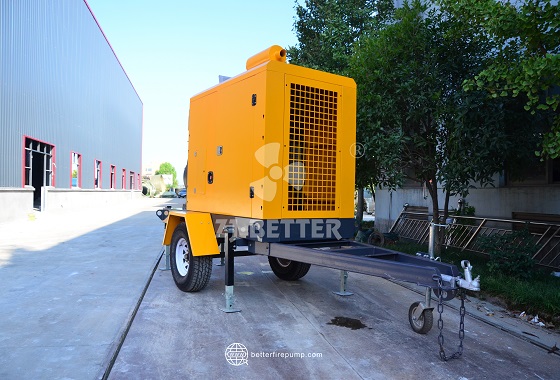In modern firefighting systems, the versatility and environmental adaptability of equipment have become crucial criteria for measuring its value. While the scenarios and conditions differ significantly between urban firefighting needs and remote emergency water supply missions, both demand efficient, reliable, and flexible equipment. Mobile fire pumps, particularly trailer-mounted diesel engine-powered models, are becoming a vital force in global emergency response efforts due to their rapid deployment, independent power supply, and all-terrain adaptability. These devices not only ensure stable water pressure in densely populated urban areas but also provide continuous water supply in remote areas without electricity or a fixed water source. This article will delve into the advantages of mobile fire pumps in various environments and comprehensively demonstrate their superior performance and value through 10 key points.
1. Independent Power System, Free from Electrical Constraints
Mobile diesel fire pumps are powered by high-performance diesel engines and are independent of external power grids. This means they can operate even during power outages, natural disasters, or in remote areas without grid coverage. With sufficient fuel supply, diesel engines can operate continuously for hours or even days, ensuring reliable operation during large fires, flood drainage, or temporary water supply operations. Compared to electric fire pumps, diesel-powered models offer advantages in coping with power fluctuations and outages, making them an ideal choice for environments without electricity.
2. Rapid Deployment, Shortening Response Time
The mobile fire pump's trailerable structure and compact design allow it to be quickly transported to the scene of an incident and put into operation without complex installation. This "ready-to-go" feature is particularly crucial in emergencies such as urban high-rise building fires, industrial park accidents, oil field explosions, and forest fires. In emergency rescue situations, time can often mean the difference between life and death, and the rapid deployment of mobile fire pumps can significantly improve rescue efficiency.
3. All-Terrain Adaptability, Suitable for Urban and Off-Road Operations
The mobile fire pump's reinforced chassis and support structure provide excellent off-road capabilities, making it suitable for complex road conditions such as mud, gravel, and slopes. Its outriggers stabilize the equipment on uneven ground, ensuring the pump's stability during operation. Whether operating on urban roads or in rugged mountainous terrain or near rivers, the mobile fire pump can perform efficiently.
4. High head and large flow rate meet water supply needs in various scenarios.
The high head design enables the mobile fire pump to maintain sufficient pressure over long distances, while the high flow rate ensures continuous water supply in high-demand scenarios. For example, the device can operate stably in urban high-rise building firefighting, where high static pressure losses must be overcome, or in forest fires, where large areas must be covered.
5. Built-in protective housing ensures 24/7 operation.
The protective housing not only protects against rain and dust, but also reduces noise, making it suitable for use in noise-sensitive areas such as residential areas and hospitals. It also protects the internal engine and pump from harsh environments, extending the device's service life. Whether exposed to scorching sun, torrential rain, or dusty weather, the device operates stably.
6. Versatile applications beyond firefighting
Beyond traditional firefighting, mobile fire pumps are also widely used in drainage, flood control, industrial emergency water supply, and dust reduction in mining areas. For example, when heavy rain causes urban flooding, the equipment can quickly pump out accumulated water. In water-scarce areas, it can provide a stable water source for construction, agriculture, or temporary camps.
7. High Fuel Efficiency and Low Maintenance Costs
Modern diesel engine technology significantly improves fuel efficiency and reduces operating costs. Combined with an optimized pump design and highly wear-resistant materials, the equipment maintains stable performance over long periods of operation, reduces failure rates, and reduces maintenance frequency. This low operating cost advantage is particularly important in remote areas where long-term deployment is required.
8. Modular Structure for Easy Maintenance and Upgrades
The mobile fire pump utilizes a modular design, allowing components such as the engine, pump body, and control system to be independently replaced or upgraded, facilitating performance adjustments based on mission requirements. This not only reduces maintenance complexity but also ensures the equipment remains in optimal working condition.
9. Intelligent Control and Remote Monitoring
Equipped with an advanced control panel and sensors, the equipment enables real-time monitoring of operating parameters, including pressure, flow, temperature, and fuel level. Optional remote monitoring allows managers to monitor equipment status from a remote location, enhancing emergency response capabilities.
10. International Standard Manufacturing and Reliable Quality
Mobile fire pumps are manufactured in accordance with international firefighting equipment standards and hold multiple quality certifications, ensuring high performance in a variety of complex environments. Whether deployed in densely populated urban communities or in remote, uninhabited areas, their reliability and durability are proven.
With its independent power supply, rapid deployment, all-terrain adaptability, and versatile applications, mobile fire pumps enable seamless coverage from urban to remote areas. In modern emergency response systems, they are more than just a piece of equipment; they are a reliable partner in safeguarding life and property. Whether facing fires, floods, or temporary water supply operations, mobile fire pumps play an irreplaceable role in critical moments.
